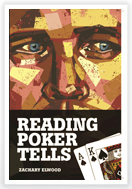 |
Author: Zachary Elwood Publisher: Via Regia Pages: 228 Pub. Date: April 2012 Price: $19.95 |
Book Review
Zachary Elwood’s “Reading Poker Tells” came out in early 2012 and is the latest book on the subject of poker tells and psychology. Elwood joins the ranks of Mike Caro and Joe Navarro as noted authors on the subject of poker tells. Most dedicated poker players have read Caro’s and Navarro’s books (or at least heard of their teachings), so the question most people would probably ask is “Why do we need another poker tells book?”
Elwood does a good job explaining why his book is different than the others and why he is contributing something new, and his arguments are good ones.
For starters, Reading Poker Tells is probably the most scientific study of poker tells out there. Elwood talks about how poker tells are very complex; it’s not just a case of “this means that.” Instead, it’s all about “correlating” (as he calls it) a player’s behavior over time and finding good patterns before basing your actions on tells.
He spends a lot of time making sure that the reader understands this point before moving on to talking about actual tells. You could argue that he belabors the point too much and that the beginning of the book is too slow, but he seems to just be trying to hammer home that there are no easy answers when it comes to tells, and that you shouldn’t rely on them at the table without a good sense of how an opponent has acted in the past.
Secondly, this is the first book to talk about the importance of the situation in interpreting poker tells. Elwood breaks down tells into three situation categories: waiting-for-action, during-action, and post-bet. He says this is important because many tells are much more likely to be exhibited in certain situations, and might even mean something completely different when seen in a different situation. (For example, he says that one major tell to look for is how much a player looks at his opponent after betting, which is a “post-bet” tell.)
Elwood makes a good case that categorizing poker tells in this way will do wonders for improving the reader’s ability to spot tells and make sense of them at the poker table. There is so much information out there that you need some sort of system to make sense of it all.
The book also has really in-depth analysis of what specific tells to look for. There are a lot of tells here that have never been written about anywhere else. For example, there is a section on verbal tells that is unique; it discusses why people lie or tell the truth, and goes into the reasons behind why people may be motivated to do those things. (This section uses a very entertaining analysis of some of Jamie Gold’s speech patterns; it does make you wish that Elwood had used more real-world examples.)
There is also an entire section about “Deception and Manipulation.” This chapter goes into various ways someone might try to get players to do what one wants or gain an edge in unfair ways. It reads, at times, like an instruction manual for “angle-shooting,” but the importance of the chapter is, as Elwood says, in guarding against players who are trying to angle-shoot you. By understanding their motivations, you can better defend against them, and even take advantage of them by using that knowledge against them.
Some things could be done better: for example, the pictures in the book were rather generic, and not much of an improvement on pictures in other poker tells books. In Elwood’s defense, however, he does point out that he does not think the pictures are that relevant to studying poker tells, just because a picture only shows you one moment, but studying poker tells is about studying people over time. So it’s a small gripe.
Probably the main takeaway from Reading Poker Tells is just how much information it is possible to gather at the poker table. Elwood talks about so many points of data that, even if you don’t agree with all of the tells he talks about, you’ll start noticing new ways to study people and gather information. And he says in the book that that is his goal; to make the reader a better observer of human nature. At the very least, this book will make sure that you do a good job covering up your own tells, which is a major part of the poker psychology battle.
Altogether, Reading Poker Tells is a very strong work. There is a lot of new information here. The most important thing of all, though, is Elwood’s organization of poker tells into categories, giving readers a “mental framework” for studying tells on their own. That will probably be what sets this book apart in the history of poker books.